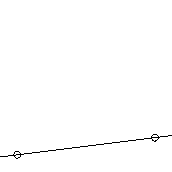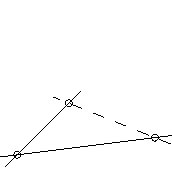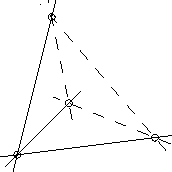Send
Close Add comments:
(status displays here)
Got it! This site "robinsnyder.com" uses cookies. You consent to this by clicking on "Got it!" or by continuing to use this website. Note: This appears on each machine/browser from which this site is accessed.
Linear equations
1. Math: dimensions
There are many ways to represent dimensions.
Geometry is used here for a discussion on dimensions.
2. Line

Any two distinct points in a plane determine a line in the plane.
A line can depict one dimension, called 1D.
3. Plane

Three distinct points determine a plane.
A plane can depict two dimensions, called 2D.
4. Space

Four distinct points determine a space.
A space can depict three dimensions, called 3D.
5. Hyper-spaces
Five or more distinct points determine a hyper-space.
A hyper-space can depict four or more dimensions, called 4D (or more).
6. Human visualization
Since humans have trouble visualizing even four dimensions, the term hype-space will be used for 4D space.
Unless otherwise specified, hyper-spaces will refer to 4 dimensions.
7. Hilbert spaces
The mathematician Hilbert generalized dimensions to a potentially infinite number of dimensions, called Hilbert spaces.
8. Visualization
The purpose of visualization of concepts is often go get in intuitive feel/view for what is happening.
The results and methods are then generalized to many more dimensions.
-
9. Linear equation
A line in two dimensions has the following form.
y = f(x) = m * x + b
The following hold.
The variable y is the dependent variable (i.e., y is a function of x). and
The variable x is the independent variable (i.e., x functionally determines y).
The value m is the slope if the line.
The value b is the intercept of the line on the y axis (i.e., when x is 0).
What is a dependent variable? Give a specific example.
What is an independent variable? Give a specific example.
10. Slope
The
slope is defined as the rise over the run.
In the linear equation
y = m * x + b
m is the slope.
11. Rise over run
The slope is the rise over the run.
The run is the horizontal displacement.
The rise is the vertical displacement.
12. Vertical displacement
For any two points
x1 and
x2 on the line, the run, or horizontal displacement, is
x2 - x1.
13. Horizontal displacement
The corresponding rise, or vertical displacement, is
f(x2) - f(x1) = y2 - y1
Substituting the definition of
f(x) in the rise yields the following.
f(x2) - f(x1)
= y2 - y1
= (m * x2 + b) - (m * x1 + b)
= m (x2 - x1)
14. Slope
So, the slope
m is the following.
rise / run
= m * (x2 - x1) / (x2 - x1)
= m
The slope can also be defined as the change in
f(x) per unit change in
x.
slope
= f(x+1) - f(x)
= m*(x+1)+b - (m*x+b)
= m*x+m+b -m*x-b
= m
15. Intercept
In math, an
intercept is the point at which two geometric objects cross paths.
In football, a defensive player can intercept a pass thrown by an offensive player.
16. Y-intercept
In a line, the y-intercept is the value of
y when the line intersects the x-axis (i.e., when
x is
0). So, the y-intercept is
f(0) = m * 0 + b = b.
So, the slope is
m and the intercept is
b.
17. Graphing a line

To graph a line, two points are needed. In general, it is best to pick the two points that are easiest to graph.
18. Graph a line
Consider the following points.
(x1, y1) = (5, 7)
(x2, y2) = (15, 17)
Since these are not the same points, these points define a line.
19. Horizontal displacement
(x1, y1) = (5, 7)
(x2, y2) = (15, 17)
What is the horizontal displacement?
The horizontal displacement is
x2-x1 =
15-5 =
10.
What is the vertical displacement?
The vertical displacement is
y2-y1 =
f(x2)-f(x1) =
17-7 =
10.
20. Slope
(x1, y1) = (5, 7)
(x2, y2) = (15, 17)
What is the slope of the line?
The slope of the line is determined as follows.
slope = m = rise / run = (17-7) / (15 - 5) = 10 / 10 = 1
21. Y-intercept
(x1, y1) = (5, 7)
(x2, y2) = (15, 17)
What is the y-intercept of the line? Since
y = m * x + b
we know the following, where
m is
1.
y2 = m * x2 + b
y1 = m * x1 + b
22. Equations
Thus we have the following two equations.
17 = 15 + b
7 = 5 + b
Solving either one will yield the result that the y-intercept
b =
2.
23. End of page
 Any two distinct points in a plane determine a line in the plane.
Any two distinct points in a plane determine a line in the plane.
 To graph a line, two points are needed. In general, it is best to pick the two points that are easiest to graph.
To graph a line, two points are needed. In general, it is best to pick the two points that are easiest to graph.